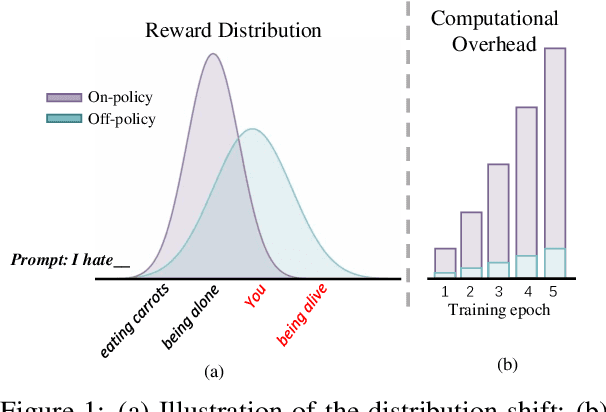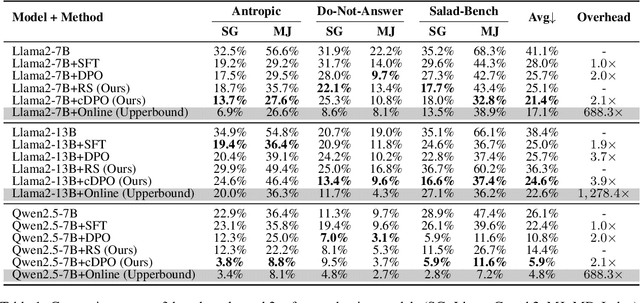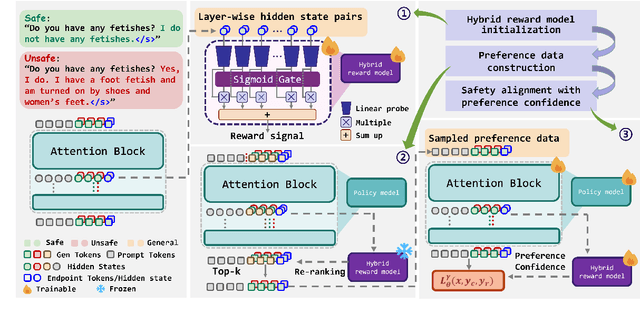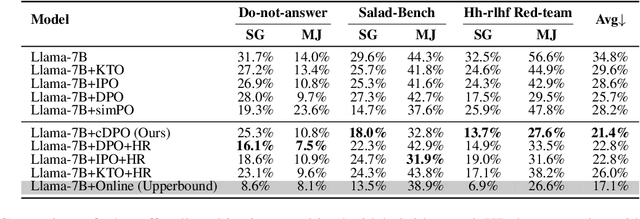Kehai Chen
From Bias to Balance: Exploring and Mitigating Spatial Bias in LVLMs
Sep 26, 2025Abstract:Large Vision-Language Models (LVLMs) have achieved remarkable success across a wide range of multimodal tasks, yet their robustness to spatial variations remains insufficiently understood. In this work, we present a systematic study of the spatial bias of LVLMs, focusing on how models respond when identical key visual information is placed at different locations within an image. Through a carefully designed probing dataset, we demonstrate that current LVLMs often produce inconsistent outputs under such spatial shifts, revealing a fundamental limitation in their spatial-semantic understanding. Further analysis shows that this phenomenon originates not from the vision encoder, which reliably perceives and interprets visual content across positions, but from the unbalanced design of position embeddings in the language model component. In particular, the widely adopted position embedding strategies, such as RoPE, introduce imbalance during cross-modal interaction, leading image tokens at different positions to exert unequal influence on semantic understanding. To mitigate this issue, we introduce Balanced Position Assignment (BaPA), a simple yet effective mechanism that assigns identical position embeddings to all image tokens, promoting a more balanced integration of visual information. Extensive experiments show that BaPA enhances the spatial robustness of LVLMs without retraining and further boosts their performance across diverse multimodal benchmarks when combined with lightweight fine-tuning. Further analysis of information flow reveals that BaPA yields balanced attention, enabling more holistic visual understanding.
XBOUND: Exploring the Capability Boundaries of Device-Control Agents through Trajectory Tree Exploration
May 27, 2025Abstract:Recent advancements in vision-language models (VLMs) have spurred increased interest in Device-Control Agents (DC agents), such as utilizing in-the-wild device control to manage graphical user interfaces. Conventional methods for assessing the capabilities of DC agents, such as computing step-wise action accuracy and overall task success rates, provide a macroscopic view of DC agents' performance; however, they fail to offer microscopic insights into potential errors that may occur in real-world applications. Conducting a finer-grained performance evaluation of DC agents presents significant challenges. This study introduces a new perspective on evaluation methods for DC agents by proposing the XBOUND evaluation method, which employs the calculation of a novel Explore Metric to delineate the capability boundaries of DC agents. Compared to previous evaluation methods, XBOUND focuses on individual states to assess the proficiency of DC agents in mastering these states. Furthermore, we have developed a ``pseudo'' episode tree dataset derived from Android Control test data. Utilizing this dataset and XBOUND, we comprehensively evaluate the OS-Atlas and UI-TARS series, examining both the overall and specific performance across five common tasks. Additionally, we select representative cases to highlight the current deficiencies and limitations inherent in both series. Code is available at https://github.com/sqzhang-lazy/XBOUND.
Evaluating and Steering Modality Preferences in Multimodal Large Language Model
May 27, 2025Abstract:Multimodal large language models (MLLMs) have achieved remarkable performance on complex tasks with multimodal context. However, it is still understudied whether they exhibit modality preference when processing multimodal contexts. To study this question, we first build a \textbf{MC\textsuperscript{2}} benchmark under controlled evidence conflict scenarios to systematically evaluate modality preference, which is the tendency to favor one modality over another when making decisions based on multimodal conflicting evidence. Our extensive evaluation reveals that all 18 tested MLLMs generally demonstrate clear modality bias, and modality preference can be influenced by external interventions. An in-depth analysis reveals that the preference direction can be captured within the latent representations of MLLMs. Built on this, we propose a probing and steering method based on representation engineering to explicitly control modality preference without additional fine-tuning or carefully crafted prompts. Our method effectively amplifies modality preference toward a desired direction and applies to downstream tasks such as hallucination mitigation and multimodal machine translation, yielding promising improvements.
MDIT-Bench: Evaluating the Dual-Implicit Toxicity in Large Multimodal Models
May 22, 2025Abstract:The widespread use of Large Multimodal Models (LMMs) has raised concerns about model toxicity. However, current research mainly focuses on explicit toxicity, with less attention to some more implicit toxicity regarding prejudice and discrimination. To address this limitation, we introduce a subtler type of toxicity named dual-implicit toxicity and a novel toxicity benchmark termed MDIT-Bench: Multimodal Dual-Implicit Toxicity Benchmark. Specifically, we first create the MDIT-Dataset with dual-implicit toxicity using the proposed Multi-stage Human-in-loop In-context Generation method. Based on this dataset, we construct the MDIT-Bench, a benchmark for evaluating the sensitivity of models to dual-implicit toxicity, with 317,638 questions covering 12 categories, 23 subcategories, and 780 topics. MDIT-Bench includes three difficulty levels, and we propose a metric to measure the toxicity gap exhibited by the model across them. In the experiment, we conducted MDIT-Bench on 13 prominent LMMs, and the results show that these LMMs cannot handle dual-implicit toxicity effectively. The model's performance drops significantly in hard level, revealing that these LMMs still contain a significant amount of hidden but activatable toxicity. Data are available at https://github.com/nuo1nuo/MDIT-Bench.
Lost in Benchmarks? Rethinking Large Language Model Benchmarking with Item Response Theory
May 21, 2025Abstract:The evaluation of large language models (LLMs) via benchmarks is widespread, yet inconsistencies between different leaderboards and poor separability among top models raise concerns about their ability to accurately reflect authentic model capabilities. This paper provides a critical analysis of benchmark effectiveness, examining main-stream prominent LLM benchmarks using results from diverse models. We first propose a new framework for accurate and reliable estimations of item characteristics and model abilities. Specifically, we propose Pseudo-Siamese Network for Item Response Theory (PSN-IRT), an enhanced Item Response Theory framework that incorporates a rich set of item parameters within an IRT-grounded architecture. Based on PSN-IRT, we conduct extensive analysis which reveals significant and varied shortcomings in the measurement quality of current benchmarks. Furthermore, we demonstrate that leveraging PSN-IRT is able to construct smaller benchmarks while maintaining stronger alignment with human preference.
MoK-RAG: Mixture of Knowledge Paths Enhanced Retrieval-Augmented Generation for Embodied AI Environments
Mar 18, 2025Abstract:While human cognition inherently retrieves information from diverse and specialized knowledge sources during decision-making processes, current Retrieval-Augmented Generation (RAG) systems typically operate through single-source knowledge retrieval, leading to a cognitive-algorithmic discrepancy. To bridge this gap, we introduce MoK-RAG, a novel multi-source RAG framework that implements a mixture of knowledge paths enhanced retrieval mechanism through functional partitioning of a large language model (LLM) corpus into distinct sections, enabling retrieval from multiple specialized knowledge paths. Applied to the generation of 3D simulated environments, our proposed MoK-RAG3D enhances this paradigm by partitioning 3D assets into distinct sections and organizing them based on a hierarchical knowledge tree structure. Different from previous methods that only use manual evaluation, we pioneered the introduction of automated evaluation methods for 3D scenes. Both automatic and human evaluations in our experiments demonstrate that MoK-RAG3D can assist Embodied AI agents in generating diverse scenes.
Adaptive Inner Speech-Text Alignment for LLM-based Speech Translation
Mar 13, 2025Abstract:Recent advancement of large language models (LLMs) has led to significant breakthroughs across various tasks, laying the foundation for the development of LLM-based speech translation systems. Existing methods primarily focus on aligning inputs and outputs across modalities while overlooking deeper semantic alignment within model representations. To address this limitation, we propose an Adaptive Inner Speech-Text Alignment (AI-STA) method to bridge the modality gap by explicitly aligning speech and text representations at selected layers within LLMs. To achieve this, we leverage the optimal transport (OT) theory to quantify fine-grained representation discrepancies between speech and text. Furthermore, we utilize the cross-modal retrieval technique to identify the layers that are best suited for alignment and perform joint training on these layers. Experimental results on speech translation (ST) tasks demonstrate that AI-STA significantly improves the translation performance of large speech-text models (LSMs), outperforming previous state-of-the-art approaches. Our findings highlight the importance of inner-layer speech-text alignment in LLMs and provide new insights into enhancing cross-modal learning.
Representation-based Reward Modeling for Efficient Safety Alignment of Large Language Model
Mar 13, 2025



Abstract:Reinforcement Learning (RL) algorithms for safety alignment of Large Language Models (LLMs), such as Direct Preference Optimization (DPO), encounter the challenge of distribution shift. Current approaches typically address this issue through online sampling from the target policy, which requires significant computational resources. In this paper, we hypothesize that during off-policy training, while the ranking order of output generated by policy changes, their overall distribution remains relatively stable. This stability allows the transformation of the sampling process from the target policy into a re-ranking of preference data. Building on this hypothesis, We propose a new framework that leverages the model's intrinsic safety judgment capability to extract reward signals, which are then used to calculate label confidence for preferences reordering. Extensive experimental results and theoretical analysis demonstrate that the proposed method effectively addresses the distribution shift issue, remarkably enhancing the safety performance while reducing about 300x computational overheads.
XIFBench: Evaluating Large Language Models on Multilingual Instruction Following
Mar 10, 2025Abstract:Large Language Models (LLMs) have demonstrated remarkable instruction-following capabilities across various applications. However, their performance in multilingual settings remains poorly understood, as existing evaluations lack fine-grained constraint analysis. We introduce XIFBench, a comprehensive constraint-based benchmark for assessing multilingual instruction-following abilities of LLMs, featuring a novel taxonomy of five constraint categories and 465 parallel instructions across six languages spanning different resource levels. To ensure consistent cross-lingual evaluation, we develop a requirement-based protocol that leverages English requirements as semantic anchors. These requirements are then used to validate the translations across languages. Extensive experiments with various LLMs reveal notable variations in instruction-following performance across resource levels, identifying key influencing factors such as constraint categories, instruction complexity, and cultural specificity.
Merge then Realign: Simple and Effective Modality-Incremental Continual Learning for Multimodal LLMs
Mar 08, 2025Abstract:Recent advances in Multimodal Large Language Models (MLLMs) have enhanced their versatility as they integrate a growing number of modalities. Considering the heavy cost of training MLLMs, it is necessary to reuse the existing ones and further extend them to more modalities through Modality-incremental Continual Learning (MCL). However, this often comes with a performance degradation in the previously learned modalities. In this work, we revisit the MCL and investigate a more severe issue it faces in contrast to traditional continual learning, that its degradation comes not only from catastrophic forgetting but also from the misalignment between the modality-agnostic and modality-specific components. To address this problem, we propose an elegantly simple MCL paradigm called "MErge then ReAlign" (MERA). Our method avoids introducing heavy training overhead or modifying the model architecture, hence is easy to deploy and highly reusable in the MLLM community. Extensive experiments demonstrate that, despite the simplicity of MERA, it shows impressive performance, holding up to a 99.84% Backward Relative Gain when extending to four modalities, achieving a nearly lossless MCL performance.
 Add to Chrome
Add to Chrome Add to Firefox
Add to Firefox Add to Edge
Add to Edge